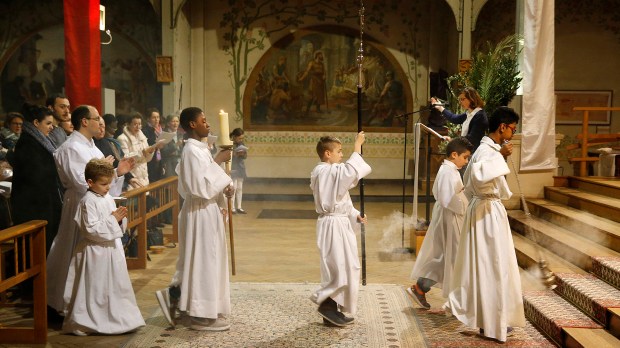A new survey is examining the demographics of incoming U.S. priests in 2022. The study was run by Georgetown University’s Center for Applied Research in the Apostolate (CARA), in collaboration with the USCCB’s Secretariats for Clergy and Consecrated Life and Vocations.
The survey, issued between January 10 and March 18, 2022, was responded to by 317 seminarians. Of these, 238 were preparing to become diocesan priests, while the remaining 79 will enter religious orders. A plurality of the ordination class of 2022 (30%) attended seminaries in the Midwest, while only 8% completed their seminary studies abroad.
The study found a correlation between discerning a vocation as a young adult and pursuing the calling to be a priest. On average, responding ordinands first explored the idea of entering a seminary at the age of 16. Those who followed their calling to seminary generally became priests 17 years after their initial discernment. The average age of the 2022 ordinand class is 33 years old, down from 36 in 1999.
Personal connection between the ordinand and religious institutes also appears to be an important factor. Respondents reported communication with members of their religious institute for an average of 6 years prior to entering. This suggests that personal outreach could be a key factor in discernment.
Foreign born priests
It was found that 74% of incoming priests in the U.S. were born in the country. Of these, roughly 60% are white, 22% are Hispanic/Latino, 11% are Asian/Pacific Islander/Native Hawaiian, and 4% are African/African American/Black.
The remaining 26% are foreign born, which has held practically stable from 28% in 1999. These ordinands mostly came from Mexico, Vietnam, Brazil, Colombia, and India. It was found that most of the foreign born ordinands came to the U.S. at the age of 20 and it took an average of 13 years to become a priest.
Education
Responses to education levels were among the most varied. Fewer than one-in-10 (9%) said they were homeschooled for an average of 8 years. As many as 42% said they attended Catholic school on the K-12 or college level.
Just under three-fifths (58%) had completed an undergraduate or graduate degree before entering seminary. Of these, the most common majors were philosophy, liberal arts, theology, business, science/math, and education.
The findings suggested that parish religious ed programs may have had an influence on discernment. Just under two-thirds (65%) reported attending religious ed programs in their local parish for seven years, on average.
Family and encouragement
A strong Catholic upbringing is still one of the most defining factors of vocational discernment. The overwhelming majority of respondents (92%) reported having been baptized as infants and 86% noted that both their parents were Catholic. Nearly all of respondents (97%) reported having been raised by their biological parents
Having a priest in the family was another factor at work, with 36% of ordinands reporting a familial connection with a priest or religious. Additionally, 90% of ordinands reported being encouraged in their studies, most often by family members or parish priests. Fewer than half (48%) reported having been discouraged in their discernment.
Prayer life and lay activities
The study suggests that an active prayer life has a great impact on vocational discernment. Nearly 3-in-4 (74%) reported regularly attending Eucharistic Adoration before entering the seminary, and 72% regularly prayed the Rosary.
These numbers fell considerably with regard to lay group activities. Fewer than half attended prayer groups or Bible study groups and about 40% went on high school retreats. At the collegiate level, this number fell even further, to about 30%.
In other lay activities only about 30% reported taking part in a Catholic campus ministry, and only a quarter of ordinands had been members of the Boy Scouts of America. A full half, however, reported having been members of a parish youth group.
Parish ministry
Participation in local parish activities was another area with varied answers. Nearly two-thirds (74%) of ordinands reported having been altar servers and 51% had spent time as lectors.
Other areas of parish ministries did not seem to have the same draw on prospective priests. Only 37% had served as extraordinary ministers of Holy Communion or catechists. These figures dropped further with regard to youth ministry (33%), and even fewer (26%) took part in music ministries.
Responding ordinands also noted several vocational programs that were beneficial to their formation as priests. Eighty-three percent of 2022’s ordinands said their Pastoral Year internship contributed to their vocation. Furthermore, nearly half of respondents reported participating in a “Come and See” weekend at their seminary or religious institute before entering.

